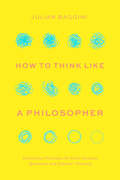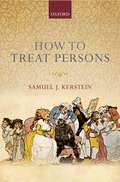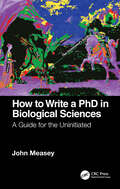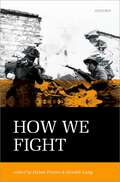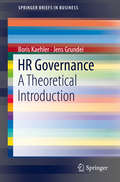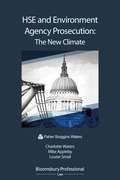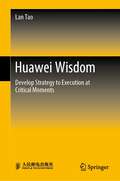- Table View
- List View
How to Think Ethically about Global Issues
by Stephen MinisterThis textbook is an introduction to thinking ethically about global issues. Unlike existing books in this area, this book is truly interdisciplinary and includes a range of voices from both the Global South and the Global North. Rather than simply applying Western theories to case studies, Prof. Stephen Minister shows readers how to consider context and complexity, while respecting the agency of people elsewhere. It weaves together the work of thinkers and writers from the Global South with philosophical work on global ethics, relevant scholarship from other academic fields, and stories from fieldwork studying global issues on four continents. The textbook explores a variety of topics, including: cultural difference, gender, population, poverty, natural disasters, and development. It then encourages students to build on these ideas and think more deeply about topics such as foreign aid, inequality, immigration, international trade, climate change, human rights, and war and terrorism. Because the book’s style is accessible and engaging, it will be an excellent text for ethics and global studies courses, as well as being of interest to general readers who want to think better about global issues.
How to Think like a Philosopher: Twelve Key Principles for More Humane, Balanced, and Rational Thinking
by Julian BagginiAn invitation to the habits of good thinking from philosopher Julian Baggini. By now, it should be clear: in the face of disinformation and disaster, we cannot hot take, life hack, or meme our way to a better future. But how should we respond instead? In How to Think like a Philosopher, Julian Baggini turns to the study of reason itself for practical solutions to this question, inspired by our most eminent philosophers, past and present. Baggini offers twelve key principles for a more humane, balanced, and rational approach to thinking: pay attention; question everything (including your questions); watch your steps; follow the facts; watch your language; be eclectic; be a psychologist; know what matters; lose your ego; think for yourself, not by yourself; only connect; and don’t give up. Each chapter is chockful of real-world examples showing these principles at work—from the discovery of penicillin to the fight for trans rights—and how they lead to more thoughtful conclusions. More than a book of tips and tricks (or ways to be insufferably clever at parties), How to Think like a Philosopher is an invitation to develop the habits of good reasoning that our world desperately needs.
How to Think like a Philosopher: Twelve Key Principles for More Humane, Balanced, and Rational Thinking
by Julian BagginiAn invitation to the habits of good thinking from philosopher Julian Baggini. By now, it should be clear: in the face of disinformation and disaster, we cannot hot take, life hack, or meme our way to a better future. But how should we respond instead? In How to Think like a Philosopher, Julian Baggini turns to the study of reason itself for practical solutions to this question, inspired by our most eminent philosophers, past and present. Baggini offers twelve key principles for a more humane, balanced, and rational approach to thinking: pay attention; question everything (including your questions); watch your steps; follow the facts; watch your language; be eclectic; be a psychologist; know what matters; lose your ego; think for yourself, not by yourself; only connect; and don’t give up. Each chapter is chockful of real-world examples showing these principles at work—from the discovery of penicillin to the fight for trans rights—and how they lead to more thoughtful conclusions. More than a book of tips and tricks (or ways to be insufferably clever at parties), How to Think like a Philosopher is an invitation to develop the habits of good reasoning that our world desperately needs.
How To Treat Persons
by Samuel J. KersteinSamuel J. Kerstein develops a new, broadly Kantian account of the ethical issues that arise when a person treats another merely as a means, that is, 'just uses' the other and thereby acts wrongly. He takes his inspiration from Immanuel Kant's 'Formula of Humanity', which commands that we treat persons never merely as means but always as ends in themselves, and then develops the ideas suggested by the Formula into clear moral principles. Kerstein questions the plausibility of an orthodox Kantian account of the dignity of persons, before going on to develop a new, detailed account of his own. Kerstein's second main goal is to show how the Kantian principles he develops shed light on pressing issues in bioethics. He investigates how, morally speaking, scarce resources such as flu vaccine ought to be distributed—and he argues that allocating such resources in order to maximize benefits can be inconsistent with respecting persons' dignity. The book explores the morality of regulated markets in organs, and contends that in many contexts, buying organs from live 'donors' fails to honour their dignity. Finally, it probes the ethics of conducting research on 'anonymized' biological samples, and of conducting placebo-controlled pharmaceutical trials in developing countries. How to Treat Persons champions the view that even if an agent gets another's voluntary, informed consent to use parts of his body for transplantation or medical research, she might nevertheless be treating him merely as a means or failing to respect his dignity.
How to Win Your Case
by Sandy KempCovers all aspects of litigation from its basics to: - pleading- preparation- negotiation - case management - conducting the hearing; and - dealing with the aftermath. It covers the conduct of civil litigation of all kinds, rather than any area of law particularly and contains examples of what can be done, how to do so, and includes how to ask questions as well as tips on what works, or does not work. The book draws on over 35 years of the authors' experience in courts and tribunals, including the making of mistakes when doing so and although based on UK principles, is relevant throughout the English- speaking world where the principles of conducting litigation are essentially the same. The book has mainly non-legal quotations as aide memoires, and is written in a way that is intended to be easy to understand, and practical, rather than academic making it ideal for anyone presenting a case before a tribunal or court.
How to Work with Sex Offenders: A Handbook for Criminal Justice, Human Service, and Mental Health Professionals (International Perspectives on Forensic Mental Health)
by Rudy Flora Michael L. KeohaneHow to Work with Sex Offenders is a cutting edge, state-of-the-art book that provides mental health professionals best practice techniques on how to clinically evaluate, interview, and treat this challenging patient population. Successful models of individual, family, and group models of psychotherapy are provided for the reader. In addition, this handbook walks the reader through the investigation, arrest, prosecution and court hearing process, from start to finish. Thoroughly revised, this new edition builds on additional research data and new information, adding advanced chapters on female offenders, Internet offenders, pornography, sexual addiction, rape and child and adolescent sexual misconduct. This is a must-read work for undergraduate and graduate students, law enforcement officers, prosecutors, judges, child protection service workers, therapists, and other professionals who work with sex offenders.
How to Work with Sex Offenders: A Handbook for Criminal Justice, Human Service, and Mental Health Professionals (International Perspectives on Forensic Mental Health)
by Rudy Flora Michael L. KeohaneHow to Work with Sex Offenders is a cutting edge, state-of-the-art book that provides mental health professionals best practice techniques on how to clinically evaluate, interview, and treat this challenging patient population. Successful models of individual, family, and group models of psychotherapy are provided for the reader. In addition, this handbook walks the reader through the investigation, arrest, prosecution and court hearing process, from start to finish. Thoroughly revised, this new edition builds on additional research data and new information, adding advanced chapters on female offenders, Internet offenders, pornography, sexual addiction, rape and child and adolescent sexual misconduct. This is a must-read work for undergraduate and graduate students, law enforcement officers, prosecutors, judges, child protection service workers, therapists, and other professionals who work with sex offenders.
How to Write a PhD in Biological Sciences: A Guide for the Uninitiated
by John MeaseyYou don’t have to be a genius to write a PhD. Of course, it will always involve a lot of hard work and dedication, but the process of writing is a whole lot easier if you understand the basic ground rules. This book is a guide through the dos and don’ts of writing a PhD. It will be your companion from the point when you decide to do a PhD, providing practical guidance to getting started, all the way through the nuts and bolts of the writing and editing process. It will also help you to get - and stay - in the right mental framework and establish good habits from the beginning, putting you in a commanding position later on. Examples are tailored to the biological sciences, offering a unique reference for PhD students in these disciplines. Embarking on a PhD doesn’t need to be daunting, even if it’s your first experience working within academia. Each short section focuses on writing - considered by many to be the most difficult aspect of a PhD - and delves into a practical detail of one aspect, from the title to the supplementary material. Whether you’re a student just starting your studies, an early career researcher or a supervisor struggling to cope, the book provides the insider information you need to get ahead.
How to Write a PhD in Biological Sciences: A Guide for the Uninitiated
by John MeaseyYou don’t have to be a genius to write a PhD. Of course, it will always involve a lot of hard work and dedication, but the process of writing is a whole lot easier if you understand the basic ground rules. This book is a guide through the dos and don’ts of writing a PhD. It will be your companion from the point when you decide to do a PhD, providing practical guidance to getting started, all the way through the nuts and bolts of the writing and editing process. It will also help you to get - and stay - in the right mental framework and establish good habits from the beginning, putting you in a commanding position later on. Examples are tailored to the biological sciences, offering a unique reference for PhD students in these disciplines. Embarking on a PhD doesn’t need to be daunting, even if it’s your first experience working within academia. Each short section focuses on writing - considered by many to be the most difficult aspect of a PhD - and delves into a practical detail of one aspect, from the title to the supplementary material. Whether you’re a student just starting your studies, an early career researcher or a supervisor struggling to cope, the book provides the insider information you need to get ahead.
How To Write Better Law Essays: Tools And Techniques For Success In Exams And Assignments (PDF)
by Steve Foster'How to Write Better Law Essays' is essential reading for anyone who is studying law and wants to improve their legal writing skills.
How To Write Better Law Essays: Tools and techniques for success in exams and assignments
by Steve FosterHow to Write Better Law Essays is your indispensable guide to succeeding in written law assessments, helping you to research, write and present assignments with the precision and clarity required to achieve the best grades at degree level.
How To Write Law Essays And Exams: (pdf)
by S. I. StrongGives students a practical and proven method of analysing and approaching questions in law, while also imparting valuable writing skills Analyses real-life student essays and offers detailed commentary highlighting the key strengths and weaknesses of each Includes helpful 'tip' boxes that help to reinforce students' learning and understanding of the process of writing law essays and exams Applicable to most substantive law courses, so the text can be used by students throughout their legal studies Accompanied by online resources: a case breakdown to help students with reading cases, frequently asked questions, and some tips on citation styles and conventions Also available as an e-book with functionality, navigation features, and links that offer extra learning support New to this Edition: Updated sample essay that runs throughout the text as an example of how to use the IRAC (Issue, Rule, Application, Conclusion) writing framework Addition of Bloom's Taxonomy to assist in understanding instructor expectations
How Unified Is the European Union?: European Integration Between Visions and Popular Legitimacy
by Lars Pehrson Lars Oxelheim Sverker GustavssonWorld politics has been surprised recently by two sudden developments. The first took place around the beginning of 2007, when the question of global warming rose abruptly to the top of the agenda, after having been a factor in the background. The second occurred in the autumn of 2008, when the rules for a global economy started inspiring great anxiety, after having been regarded as a source of stability. These two shifts took place independently, but their consequences will require common management. The regulatory structure underlying the world’s economic, legal, and political systems needs to be revised. This presents the EU with the greatest challenge it has ever faced. The point is that this global challenge comes on top of the pr- lems already posed by markets, welfare states, security, energy, and movements of population. The additional challenge is furthermore of such a kind that a deeper discussion of the very structure of the Union is difficult to avoid.
How We Fight: Ethics in War (Mind Association Occasional Series)
How We Fight: Ethics in War presents a substantial body of new work by some of the leading philosophers of war. The ten essays cover a range of topics concerned with both jus ad bellum (the morality of going to war) and jus in bello (the morality of fighting in war). Alongside explorations of classic in bello topics, such as the principle of non-combatant immunity and the distribution of risk between combatants and non-combatants, the volume also addresses ad bellum topics, such as pacifism and punitive justifications for war, and explores the relationship between ad bellum and in bello topics, or how the fighting of a war may affect our judgments concerning whether that war meets the ad bellum conditions. The essays take a keen interest in the micro-foundations of just war theory, and uphold the general assumption that the rules of war must be supported, if they are going to be supported at all, by the liability and non-liability of the individuals who are encompassed by those rules. Relatedly, the volume also contains work which is relevant to the moral justification of several moral doctrines used, either explicitly or implicitly, in just war theory: in the doctrine of double effect, in the generation of liability in basic self-defensive cases, and in the relationship between liability and the conditions which are normally appended to permissible self-defensive violence: imminence, necessity, and proportionality. The volume breaks new ground in all these areas.
How We Hope: A Moral Psychology
by Adrienne MartinWhat exactly is hope and how does it influence our decisions? In How We Hope, Adrienne Martin presents a novel account of hope, the motivational resources it presupposes, and its function in our practical lives. She contends that hoping for an outcome means treating certain feelings, plans, and imaginings as justified, and that hope thereby involves sophisticated reflective and conceptual capacities. Martin develops this original perspective on hope--what she calls the "incorporation analysis"--in contrast to the two dominant philosophical conceptions of hope: the orthodox definition, where hoping for an outcome is simply desiring it while thinking it possible, and agent-centered views, where hoping for an outcome is setting oneself to pursue it. In exploring how hope influences our decisions, she establishes that it is not always a positive motivational force and can render us complacent. She also examines the relationship between hope and faith, both religious and secular, and identifies a previously unnoted form of hope: normative or interpersonal hope. When we place normative hope in people, we relate to them as responsible agents and aspire for them to overcome challenges arising from situation or character. Demonstrating that hope merits rigorous philosophical investigation, both in its own right and in virtue of what it reveals about the nature of human emotion and motivation, How We Hope offers an original, sustained look at a largely neglected topic in philosophy.
How We Hope: A Moral Psychology
by Adrienne MartinWhat exactly is hope and how does it influence our decisions? In How We Hope, Adrienne Martin presents a novel account of hope, the motivational resources it presupposes, and its function in our practical lives. She contends that hoping for an outcome means treating certain feelings, plans, and imaginings as justified, and that hope thereby involves sophisticated reflective and conceptual capacities. Martin develops this original perspective on hope--what she calls the "incorporation analysis"--in contrast to the two dominant philosophical conceptions of hope: the orthodox definition, where hoping for an outcome is simply desiring it while thinking it possible, and agent-centered views, where hoping for an outcome is setting oneself to pursue it. In exploring how hope influences our decisions, she establishes that it is not always a positive motivational force and can render us complacent. She also examines the relationship between hope and faith, both religious and secular, and identifies a previously unnoted form of hope: normative or interpersonal hope. When we place normative hope in people, we relate to them as responsible agents and aspire for them to overcome challenges arising from situation or character. Demonstrating that hope merits rigorous philosophical investigation, both in its own right and in virtue of what it reveals about the nature of human emotion and motivation, How We Hope offers an original, sustained look at a largely neglected topic in philosophy.
How Westminster Works . . . and Why It Doesn't: The instant Sunday Times bestseller from the ultimate political insider
by Ian DuntWhy do some prime ministers manage to get things done, while others miserably fail? What is a 'special adviser' and how did they take over British political life? And why is the House of Lords more functional than most people think?Most of us have a sense that our political system doesn't seem to work, but struggle to articulate exactly why. And for good reason: our political and financial institutions are cloaked in secrecy, archaic terminology, ancient custom and impenetrable jargon. Now, expert political journalist Ian Dunt is lifting the lid on British politics to expose every aspect of the setup in a way that can be understood and challenged. From Downing Street to Whitehall, the Commons to the Lords, this book is an indispensable guide to our political system - and how we might begin to fix it.
HR Governance: A Theoretical Introduction (SpringerBriefs in Business)
by Boris Kaehler Jens GrundeiHuman resource (HR) governance is a relatively new construct that has recently begun attracting more and more attention in both research and practice. As a part of corporate governance, it represents the internal and external normative framework of human resource management and its supervision in organizations. This book theoretically integrates HR governance with the related domains of corporate governance, general management, HR management, and leadership. By doing so, it provides scholars and practitioners in the field with a precisely delineated system of theoretical concepts for their work and helps to translate these concepts into concrete research questions and practical guidelines. By interpreting the new ISO 30408 norm on human governance and taking into account recent developments, the book helps to comply with and anticipate current and future HR regulations.
HR Management in the Forensic Science Laboratory: A 21st Century Approach to Effective Crime Lab Leadership
by John M. CollinsHR Management in the Forensic Science Laboratory: A 21st Century Approach to Effective Crime Lab Leadership introduces the profession of forensic science to human resource management, and vice versa. The book includes principles of HR management that apply most readily, and most critically, to the practice of forensic science, such as laboratory operations, staffing and assignments, laboratory relations and high impact leadership. A companion website hosts workshop PowerPoint slides, a forensic HR newsletter and other important HR strategies to assist the reader.Provides principles of HR management that readily apply to the practice of forensic scienceCovers and emphasizes the knowledge necessary to make HR management in the forensic science laboratory effective, such as technical standards and practices, laboratory structures and work units, and quality system management Includes an online website that hosts workshop PowerPoint slides, a forensic HR newsletter and other important HR strategies
HRM in Mission Driven Organizations: Managing People in the Not for Profit Sector
by Chris Brewster Jean-Luc CerdinThis edited collection examines human resource management in organizations other than those that are set up to make a profit. Covering human resource management in a number of different kinds of mission-driven organizations, the book explores organizations in sectors and industries such as the governmental and intergovernmental public sector, volunteer organizations and charities, religious organizations, cultural organizations, sports organizations and B-corporations. Recognizing the reality of management practice in the (many small) organizations covered by the book, the chapters deal with the way that people are actually managed whether or not there is an HRM department present. Students of business management and human resource management will find this book invaluable as a source of knowledge on not for profit organizations, as many of the chapters include detailed examples and case studies.
HSBA Handbook on Ship Finance
by Orestis Schinas Carsten Grau Max JohnsThis book is a major work that focuses exclusively on ship finance and includes contributions on the increasingly complex field of ship finance, which has over the last two decades become a key aspect in the world of shipping and ship owning. The book offers an enlightening mix of theoretical analysis and well-founded practical insights into the daily markets. Given that ship finance continues to develop dynamically around the world, the book covers subjects ranging from the German KG market to Islamic Finance, from loans to legal aspects and from asset pricing to risk management.
HSE and Environment Agency Prosecution: The New Climate
by Charlotte Waters Mike Appleby Louise SmailSentencing guidelines impose tough penalties for health and safety and environmental offences: how can you avoid them? The introduction of the sentencing guidelines in February 2016 has seen health and safety prosecutions treble, particularly in relation to corporate manslaughter, with tougher penalties imposed and fines exceeding £20 million being handed down. With fines having a detrimental effect on both turnover and reputation, how can companies protect themselves? HSE and Environment Agency Prosecution: The New Climate is an accessible reference work that provides guidance to ensure that companies have the correct, stringent risk management and procedures in place in order to protect themselves against exposure to such fines. Through the use of worked cases studies, checklists and charts the expert advice provided is put into context, whether you are a practitioner needing to advise your client, a company director, an in-house lawyer, or a health and safety professional. Split into four sections, this new title covers:Managing Risk; The Law; Enforcement and Sentencing; Inquests and Claims.
Huawei Wisdom: Develop Strategy to Execution at Critical Moments
by Lan TaoThis book reviews the three life-and-death crisis moments that Huawei experienced during its growth and the major transformation process triggered by these crises. It describes in detail how Huawei thinks about future strategies at these critical moments and how to implement these strategies during its daily work. This book involves the content of corporate globalization strategy decision making, overseas marketing, change management, etc.This book is suitable for middle and senior managers of the enterprises facing difficulties in product development, market development, and business model transformation, especially in the information and communication industry, manufacturing, etc. And it helps to inspire researchers and students, consultants, and trainers who major in corporate transformation, strategic management, and international marketing.
Huber and Headrick's Handwriting Identification: Facts and Fundamentals, Second Edition
by Heidi H. Harralson Larry S. Miller"Forensic document examination is the study of physical evidence and physical evidence cannot lie. Only its interpretation can err. Only the failure to find it, or to hear its true testimony can deprive it of its value."—Roy Huber This is a comprehensive update of Huber and Headrick's seminal work on handwriting examination. New coverage includes a review of forensic handwriting examination research, handwriting analysis training and proficiency, revised methods and procedures, an updated listing and clarification of terminology and electronic signatures, the analysis of digitized handwriting, and other related technological advances. The book includes updated photographs, several added illustrations, and advances in techniques based on the scientific research conducted in the area over the last 20 years. Features of the new edition include: The latest on electronic signatures, digital handwriting, automated handwriting verification, and the many advances in technology and research over the last two decades An overview of the fundamentals of handwriting examination with updated discussion of the intrinsic and extrinsic variables associated with handwriting identification A review of the criticism of handwriting expert opinions and methodology, addressing both the strengths and scientific limitations of the area Fully revised while remaining true to the spirit and approach of original authors Roy Huber and A. M. Headrick Addition of nearly 200 new references and new glossary terms representing advances in research and methods. With extensive photographs to help clearly illustrate concepts, Huber and Headrick’s Handwriting Identification: Facts and Fundamentals, Second Edition serves as an invaluable reference to law libraries, practicing document examiners, forensic and criminal justice students, and every lawyer handling cases in which the authenticity of handwriting and documents might be disputed.
Huber and Headrick's Handwriting Identification: Facts and Fundamentals, Second Edition
by Heidi H. Harralson Larry S. Miller"Forensic document examination is the study of physical evidence and physical evidence cannot lie. Only its interpretation can err. Only the failure to find it, or to hear its true testimony can deprive it of its value."—Roy Huber This is a comprehensive update of Huber and Headrick's seminal work on handwriting examination. New coverage includes a review of forensic handwriting examination research, handwriting analysis training and proficiency, revised methods and procedures, an updated listing and clarification of terminology and electronic signatures, the analysis of digitized handwriting, and other related technological advances. The book includes updated photographs, several added illustrations, and advances in techniques based on the scientific research conducted in the area over the last 20 years. Features of the new edition include: The latest on electronic signatures, digital handwriting, automated handwriting verification, and the many advances in technology and research over the last two decades An overview of the fundamentals of handwriting examination with updated discussion of the intrinsic and extrinsic variables associated with handwriting identification A review of the criticism of handwriting expert opinions and methodology, addressing both the strengths and scientific limitations of the area Fully revised while remaining true to the spirit and approach of original authors Roy Huber and A. M. Headrick Addition of nearly 200 new references and new glossary terms representing advances in research and methods. With extensive photographs to help clearly illustrate concepts, Huber and Headrick’s Handwriting Identification: Facts and Fundamentals, Second Edition serves as an invaluable reference to law libraries, practicing document examiners, forensic and criminal justice students, and every lawyer handling cases in which the authenticity of handwriting and documents might be disputed.

